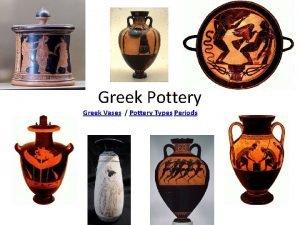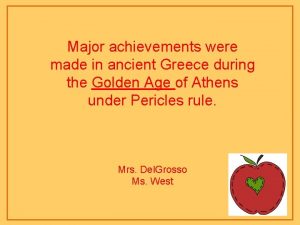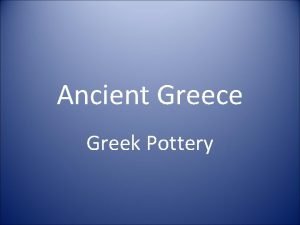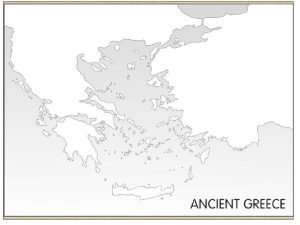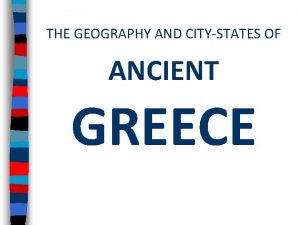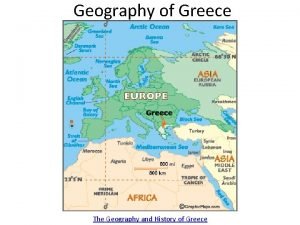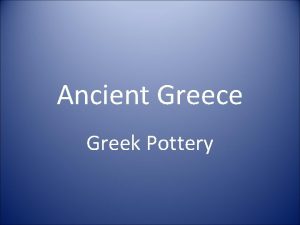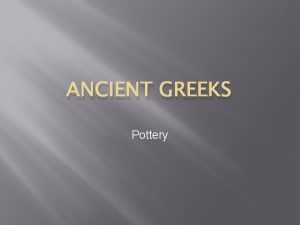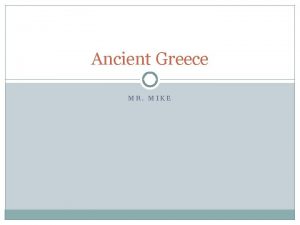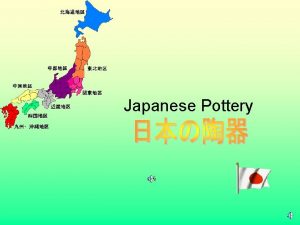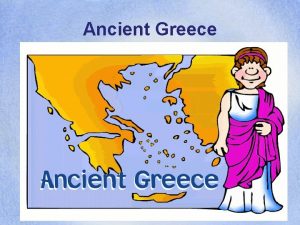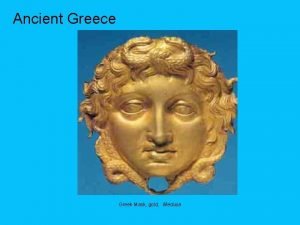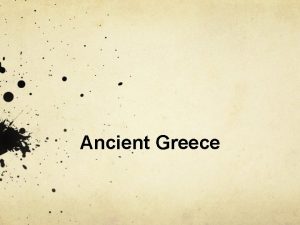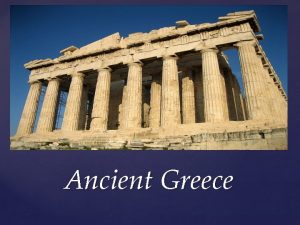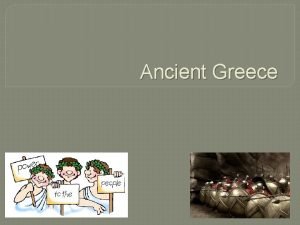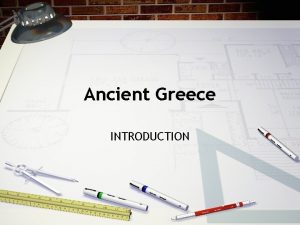Ancient Greece Greek Pottery How were pots made


















- Slides: 18

Ancient Greece Greek Pottery

How were pots made? • Potters worked as professional craftsmen in family groups – in cities like Corinth and Athens. • It is likely that the children in the family grew up learning the craft and would be involved at an early age, turning the potters wheel.

Ways of making pots. • Most of the pots were made of clay on a potters’ wheel and built up in sections. • Sometimes moulds shaped like animals heads or peoples heads were used.

Storage jars • The enormous storage jars were probably constructed by coiling the clay at first, then smoothing out. • The pointed end meant that they had to be leant against walls to stand up.

Clues in the pottery • Historians use a variety of sources to discover what life was like in ancient Greece. • Archaeologists have uncovered remains of buildings, weapons, coins and jewellery, but it is the pottery that gives some of the greatest clues of what it was like to live in Greece all those years ago.

Look at this painting from a Greek vase. What does it tell you about Greek clothes, hairstyles, furniture and pottery decoration?

What were the pots used for? • Many of the pots were used to hold and serve wine and water at the drinkingparties. • The Greeks used pots filled with olive oil as prizes for the Games at Athens. • The larger pots were used to transport wine and oil. • Some of the slender flasks would have been filled with perfumed oil and used at funerals.

And how did they decorate the pots? • • To decorate the pots, Greeks used special methods called black-figure and red-figure painting. Look at these two vases: • Can you see the difference in the colours of decoration? • The orangey red is the natural colour of the clay. In blackfigure vases, the decoration is painted on in black and the background is left the colour of the clay. • The background is painted on red-figure vases. • As you look at different pictures of Greek pottery, you will be able to tell whether the decoration is black-figure or red-figure.

Strong designs • Look at the regular patterning. • It is known as the Greek key design.

Greek Geometric Vase with Horse and Chariot • • • Some geometric designs looked like woven baskets. They have simple bands of lines, some with a crisscross pattern going around the vase. Then designs changed to simple geometric shape patterns with squares, triangles, and checkerboards. Later they changed again to images of animals and human figures. Sometimes a figure would stand alone, but mostly the animals and humans became another frieze surrounding the vase forming a repeating pattern of a single pose. Artists seemed to place the most important figures near the handle zone. This seems to be the first attempt at story telling on a vase.

Geometric Greek Vase with Horses

Double Sphinx Greek Geometric Black Figure Vase • The Greek Sphinx has a woman's head, lion's body, serpent's tail, and eagle's wings. She was sent by Hera to punish Thebes. The people from the island of Naxos gave this Sphinx to the city of Delphi as a gift to the oracle.

Greek Charioteer Geometric Hydria Vase • This vase is from 800 B. C. • It shows a warrior and his stately horses. • The rest of the vase is covered with geometric patterns, which encircle the piece at the top and bottom.

Pottery and Greek gods • Although much has been learnt from the ruins of Greek temples, Greek pottery has played an important role in showing historians the way the Greeks worshipped and illustrating their gods.

Pottery and Greek Games Looking at the Olympics today it is hard to believe that this great celebration of sport was once just a part of a local religious event. Even though the Olympic games were first recorded in 776 BC, they are believed to date back to 13 th century when people of Olympia gathered to worship the most powerful of Greek gods, Zeus. They are believed to have organised sports competitions in his honour. Little did they know that ages later their tradition would turn into an outstanding festival, which attracts hundreds of athletes and millions of viewers worldwide.

Pottery and everyday life • Much can be learnt about the way of life in Ancient Greece by the decoration on Greek pottery. • What scenes do you think are depicted on these vases?

Design your own vase • Design your own pot. Decide on the scene you want to portray. It could be about the Olympic Games, Greek gods, trade, warfare or everyday life in Ancient Greece. • Decide if it will be a blackfigure vase or a red-figure vase. Do you remember the difference?

LOTS OF DIFFERENT SHAPES AND SIZES Use these shapes to help you decide how to draw your own pot.
 Types of greek vases
Types of greek vases Major achievements of ancient greece
Major achievements of ancient greece Ancient african pottery
Ancient african pottery Beate kuhn famous artwork
Beate kuhn famous artwork Greek coil pots
Greek coil pots Why were ancient greek communities isolated
Why were ancient greek communities isolated What did greek actors wear
What did greek actors wear Locate and label the cities of athens and sparta
Locate and label the cities of athens and sparta Where was ancient greece located
Where was ancient greece located The legacy of ancient greece chapter 31 answers
The legacy of ancient greece chapter 31 answers Ancient greece geography
Ancient greece geography Spartan and athenian education
Spartan and athenian education Legacies of ancient greece
Legacies of ancient greece Map of ancient greece labeled
Map of ancient greece labeled Ancient greece map balkan peninsula
Ancient greece map balkan peninsula What can we learn from studying ancient greek artwork
What can we learn from studying ancient greek artwork The legacy of ancient greece
The legacy of ancient greece Greek stringed instrument
Greek stringed instrument What did the greeks value
What did the greeks value
